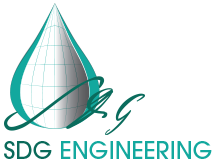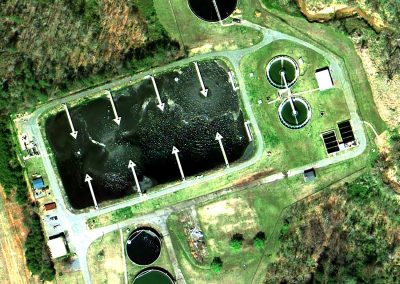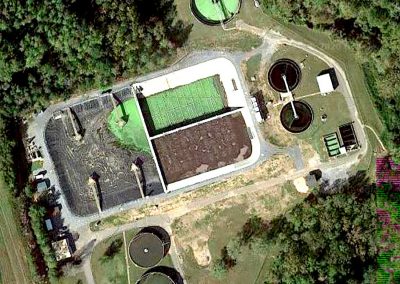
Spindale Wastewater Treatment Plant Rehabilitation
Built in 1970 this six million gallon per day wastewater treatment plant (WWTP) was in need of major improvements. The rehabilitation of the wastewater treatment plant focused on addressing problems associated with the existing eight million gallon earthen basin utilized as an aeration basin for the extended air, activated sludge treatment process. The oxygen addition and mixing equipment for the activated sludge treatment process was, prior to rehabilitation, provided by eight one hundred horsepower surface mounted vertical turbine aerators (SIMCAR).
Planning and Engineering Report
This Project was Asset Management driven. It was the highest rated project in the Capital Improvement Plan resulting from the Asset Management Plan developed by SDG Engineering, Inc. in 2012 and approved by the NC Department of Environmental Quality (DEQ).
One of the key aspects of the plant rehabilitation was to derate capacity of the WWTP from six million gallons per day to three million gallons per day. The reason for the derating was due to the fact that 90% of the textile manufacturing in the Town of Spindale had been shut down. The following alternatives were considered in the Engineering Report and Environmental Information Document (ER & EID).
- Repair and/or replace the original equipment to re-establish the original design intent of the extended air, activated sludge treatment process and reset its useful service life.
- Rehabilitate the existing aeration basin utilizing new equipment based on traditional fixed-bottom, fine bubble tube diffusers.
- Rehabilitate the existing aeration basin utilizing new equipment with a floating chain type fine bubble diffuser system similar to the Biolac ® Wastewater Treatment Process manufactured by the Parkson Corporation.
- Replace the existing aeration basin entirely with a new Vertical Loop Reactor (VLR) System.
Funding
The project was funded by a nine million dollar, zero percent, twenty year loan through the NC DWI Clean Water Sate Revolving Fund program. One million dollars of this loan was forgiven by the DWI (as a form of grant).
Construction
In the spring of 2016 the project was awarded to Brushy Mountain Builders of Hudson, NC as the Prime Contractor. Construction of the project included these notable features.
- Dredging the eight million gallon aeration basin of biosolids that had accumulated since it first went online in 1970; this was after about 54 years of operation. Nearly 1,000 Dry Tons of biosolids were removed and legally disposed of in a permitted landfill.
- Splitting the existing eight million gallon aeration basin into two sections using a cofferdam (wet and dry sections). The wet section provided wastewater treatment during construction. The dry section was rehabilitated with traditional fixed-bottom, fine bubble, three-inch diameter tube diffusers manufactured by Stamford Scientific International, Poughkeepsie, New York (SSI).
- Installing Vibratory Stone Columns to provide additional support under the concrete foundation of the concrete dividing walls in the aeration basins.
- Installing three one hundred and fifty horsepower rotary lobe blowers manufactured by Robuschi (Gardner Denver).
- Operating the blowers automatically, which was accomplished by:
- Breaking up the fixed bottom fine-bubble, tube diffuses into four separate grids.
- Monitoring the Dissolved Oxygen (DO) levels in each of the four separate grids.
- Monitoring the amount of air being delivered to each grid with air flow meters.
- Adjusting the amount of air delivered to each grid by means of Variable Frequency Drives on each blower coupled with independent electrically actuated air valves on each grid.
- Using a Programmable Logic Controller (PLC) to control the SCADA functions.
- Converting what was identified as the “wet section” during construction into an Equalization Basin. This was done after the “dry section” was converted to the new activated sludge section and placed online for treatment.
Construction was substantially completed in 2019. It has been in operation since that time.
Operation
Effluent limits are substantially below the NPDES permit limits. The average daily design flow of the WWTP is now three million gallons per day. The current average daily flow is below one million gallons per day. Therefore, the WWTP has substantial future capacity for growth.
Commendation
This project was highly acclaimed by the Asheville Regional Office of the NC Department of Environmental Quality which was responsible for oversight during construction. See their letter of commendation. In this letter of commendation, the reference to “the Town’s Consulting Engineer” is SDG Engineering, Inc. and the reference to the “Prime Contractor” is Brushy Mountain Builders.
Contact us about your water or wastewater engineering project!


